Nursing Project: Strategies to Prevent HIPAA Violations in Hospitals
VerifiedAdded on 2021/11/01
|9
|1876
|46
Project
AI Summary
This nursing project addresses the critical issue of HIPAA violations within healthcare settings, specifically focusing on the unauthorized access of electronic hospital records by staff. The project's background highlights the importance of patient confidentiality and the legal ramifications of breaches, emphasizing the role of HIPAA in protecting sensitive patient information. The project aims to enhance staff awareness, sensitivity, and adherence to information security protocols through a three-phase plan: initiation (assessing staff perceptions), preparation (knowledge enhancement and training), and change implementation (software and committee implementation). The project's design includes interviews, training sessions, and the implementation of monitoring software to detect and prevent future violations, ultimately aiming to foster a culture of respect for patient data and compliance with HIPAA regulations. The project emphasizes the need for a shift in perception and culture among healthcare professionals to ensure patient privacy and data security.
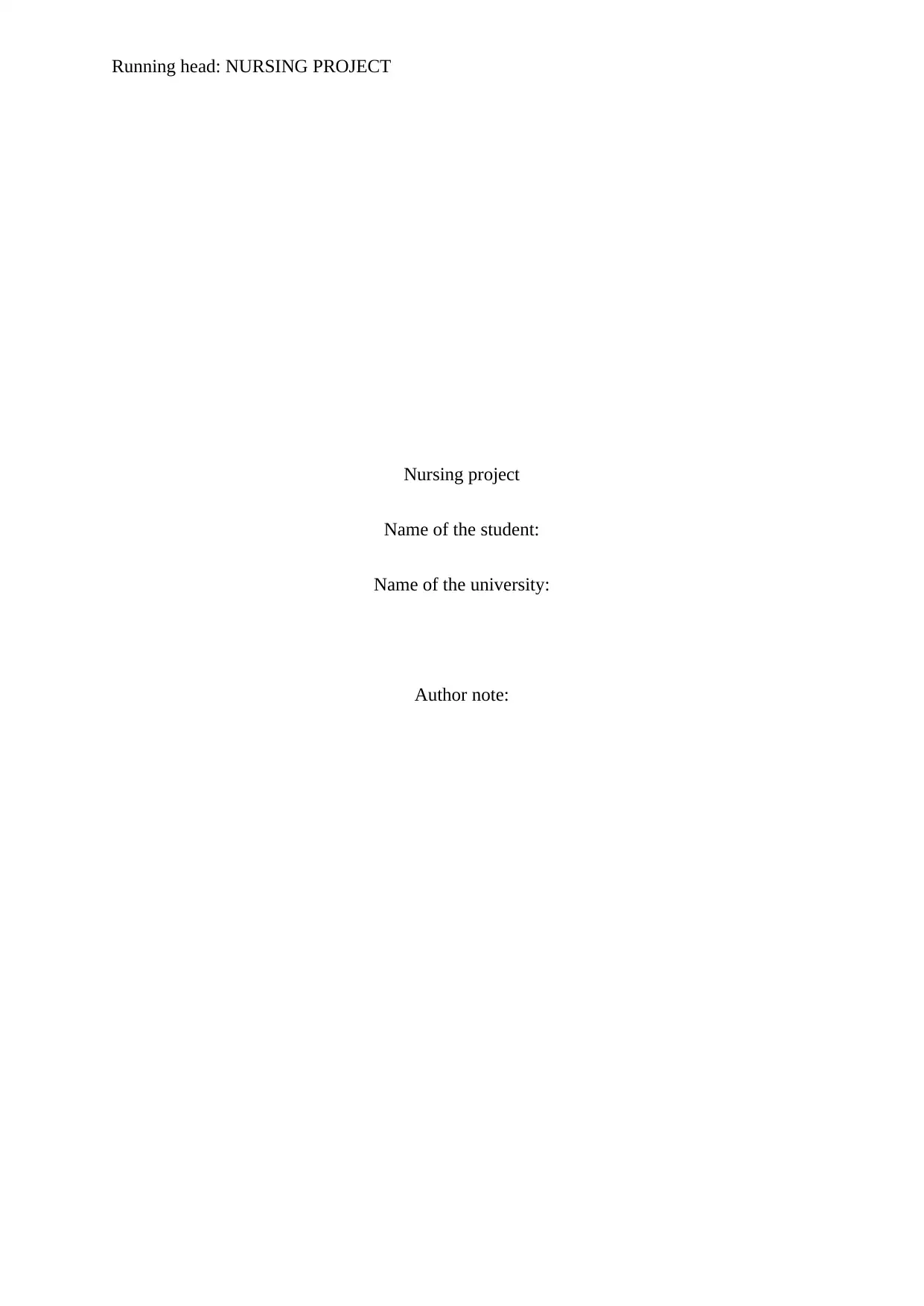
Running head: NURSING PROJECT
Nursing project
Name of the student:
Name of the university:
Author note:
Nursing project
Name of the student:
Name of the university:
Author note:
Paraphrase This Document
Need a fresh take? Get an instant paraphrase of this document with our AI Paraphraser
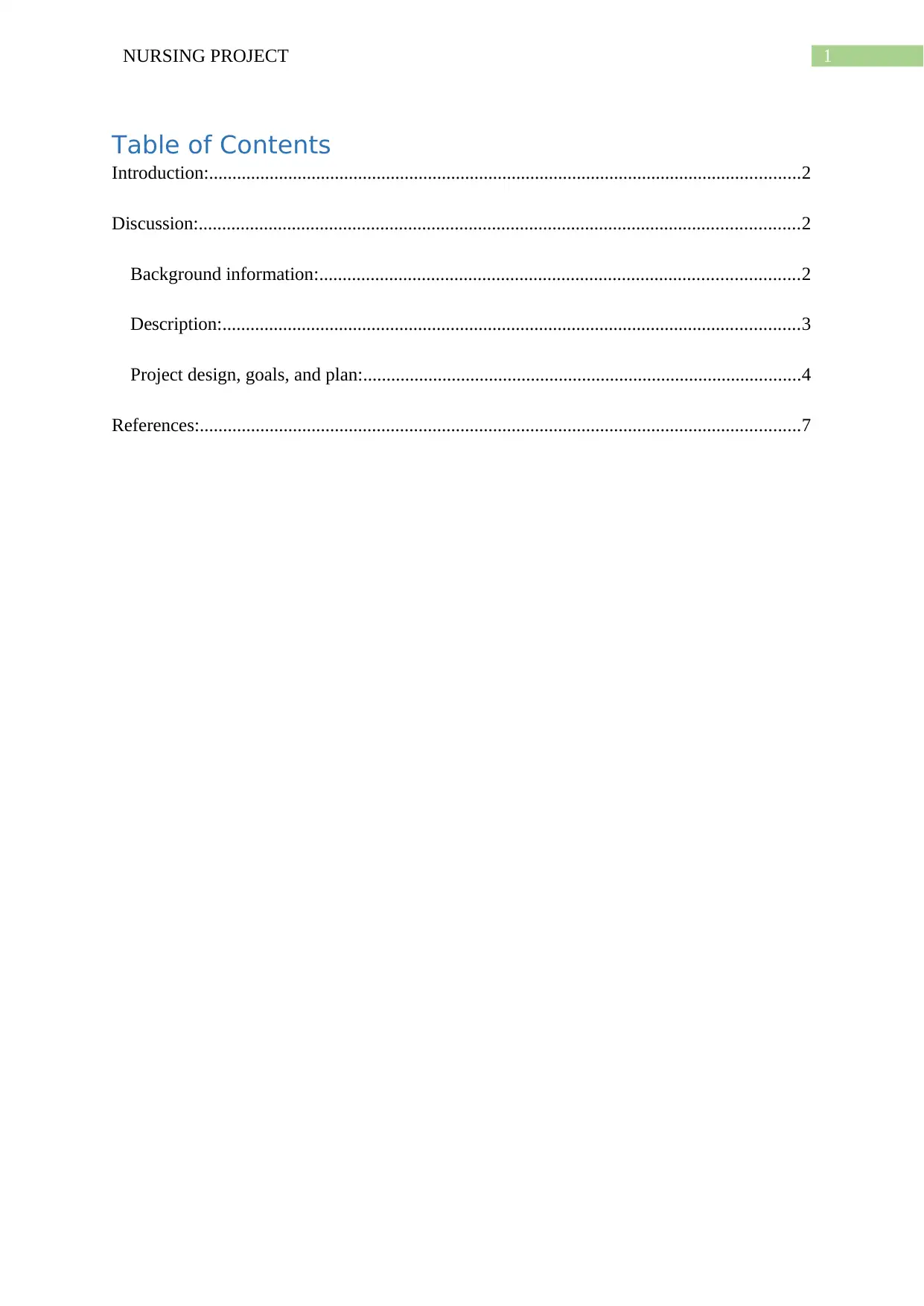
1NURSING PROJECT
Table of Contents
Introduction:...............................................................................................................................2
Discussion:.................................................................................................................................2
Background information:.......................................................................................................2
Description:............................................................................................................................3
Project design, goals, and plan:..............................................................................................4
References:.................................................................................................................................7
Table of Contents
Introduction:...............................................................................................................................2
Discussion:.................................................................................................................................2
Background information:.......................................................................................................2
Description:............................................................................................................................3
Project design, goals, and plan:..............................................................................................4
References:.................................................................................................................................7
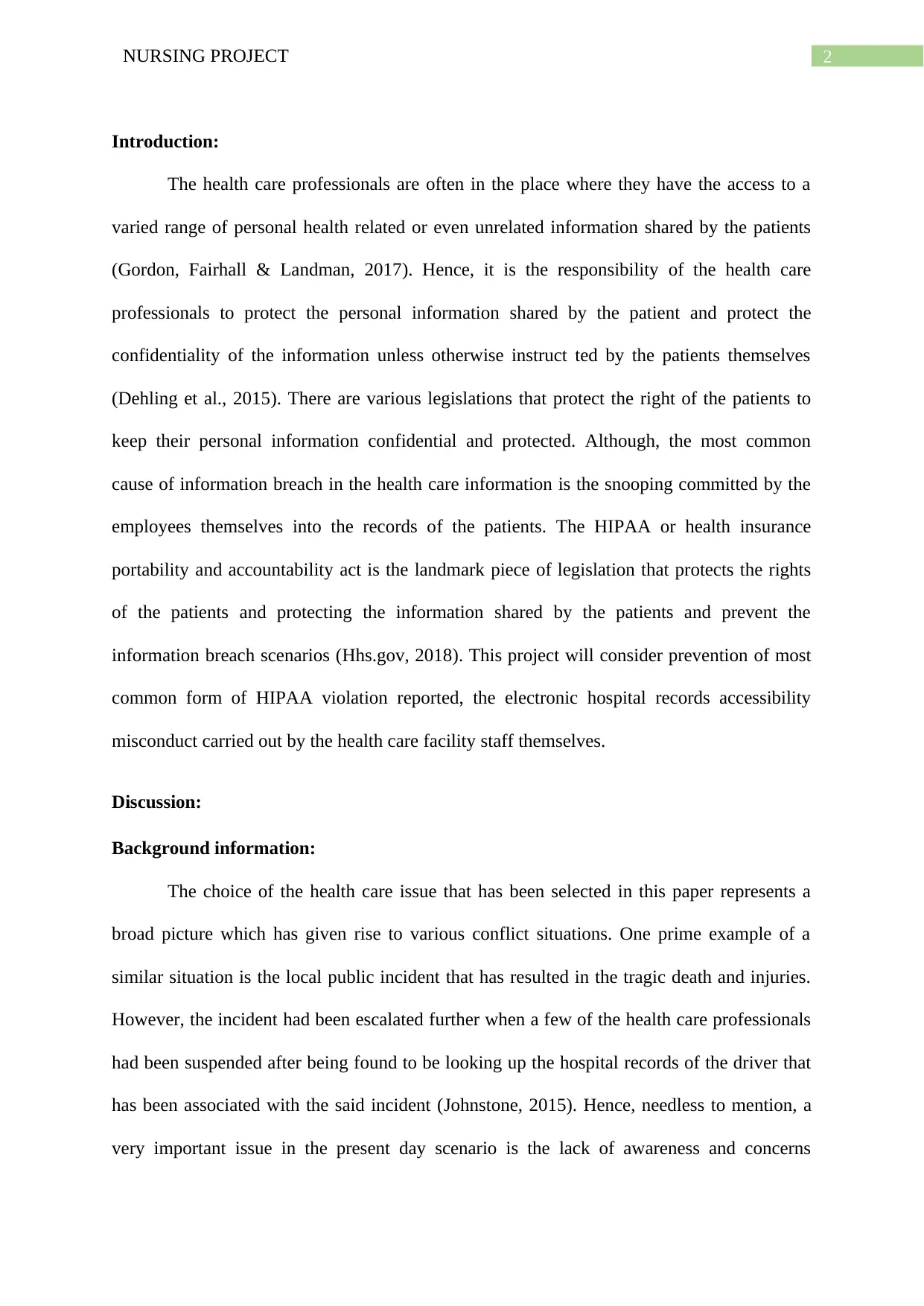
2NURSING PROJECT
Introduction:
The health care professionals are often in the place where they have the access to a
varied range of personal health related or even unrelated information shared by the patients
(Gordon, Fairhall & Landman, 2017). Hence, it is the responsibility of the health care
professionals to protect the personal information shared by the patient and protect the
confidentiality of the information unless otherwise instruct ted by the patients themselves
(Dehling et al., 2015). There are various legislations that protect the right of the patients to
keep their personal information confidential and protected. Although, the most common
cause of information breach in the health care information is the snooping committed by the
employees themselves into the records of the patients. The HIPAA or health insurance
portability and accountability act is the landmark piece of legislation that protects the rights
of the patients and protecting the information shared by the patients and prevent the
information breach scenarios (Hhs.gov, 2018). This project will consider prevention of most
common form of HIPAA violation reported, the electronic hospital records accessibility
misconduct carried out by the health care facility staff themselves.
Discussion:
Background information:
The choice of the health care issue that has been selected in this paper represents a
broad picture which has given rise to various conflict situations. One prime example of a
similar situation is the local public incident that has resulted in the tragic death and injuries.
However, the incident had been escalated further when a few of the health care professionals
had been suspended after being found to be looking up the hospital records of the driver that
has been associated with the said incident (Johnstone, 2015). Hence, needless to mention, a
very important issue in the present day scenario is the lack of awareness and concerns
Introduction:
The health care professionals are often in the place where they have the access to a
varied range of personal health related or even unrelated information shared by the patients
(Gordon, Fairhall & Landman, 2017). Hence, it is the responsibility of the health care
professionals to protect the personal information shared by the patient and protect the
confidentiality of the information unless otherwise instruct ted by the patients themselves
(Dehling et al., 2015). There are various legislations that protect the right of the patients to
keep their personal information confidential and protected. Although, the most common
cause of information breach in the health care information is the snooping committed by the
employees themselves into the records of the patients. The HIPAA or health insurance
portability and accountability act is the landmark piece of legislation that protects the rights
of the patients and protecting the information shared by the patients and prevent the
information breach scenarios (Hhs.gov, 2018). This project will consider prevention of most
common form of HIPAA violation reported, the electronic hospital records accessibility
misconduct carried out by the health care facility staff themselves.
Discussion:
Background information:
The choice of the health care issue that has been selected in this paper represents a
broad picture which has given rise to various conflict situations. One prime example of a
similar situation is the local public incident that has resulted in the tragic death and injuries.
However, the incident had been escalated further when a few of the health care professionals
had been suspended after being found to be looking up the hospital records of the driver that
has been associated with the said incident (Johnstone, 2015). Hence, needless to mention, a
very important issue in the present day scenario is the lack of awareness and concerns
⊘ This is a preview!⊘
Do you want full access?
Subscribe today to unlock all pages.

Trusted by 1+ million students worldwide
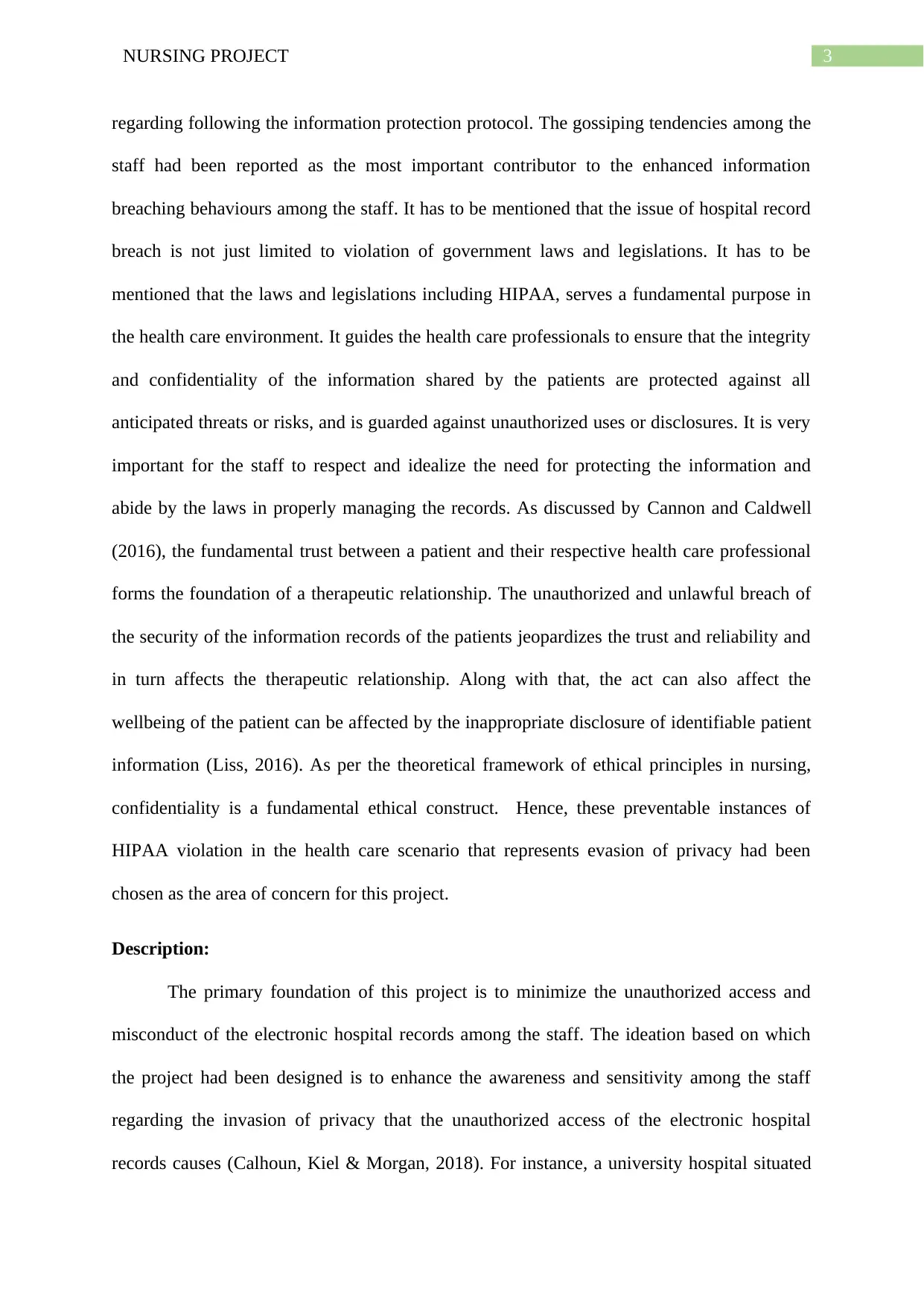
3NURSING PROJECT
regarding following the information protection protocol. The gossiping tendencies among the
staff had been reported as the most important contributor to the enhanced information
breaching behaviours among the staff. It has to be mentioned that the issue of hospital record
breach is not just limited to violation of government laws and legislations. It has to be
mentioned that the laws and legislations including HIPAA, serves a fundamental purpose in
the health care environment. It guides the health care professionals to ensure that the integrity
and confidentiality of the information shared by the patients are protected against all
anticipated threats or risks, and is guarded against unauthorized uses or disclosures. It is very
important for the staff to respect and idealize the need for protecting the information and
abide by the laws in properly managing the records. As discussed by Cannon and Caldwell
(2016), the fundamental trust between a patient and their respective health care professional
forms the foundation of a therapeutic relationship. The unauthorized and unlawful breach of
the security of the information records of the patients jeopardizes the trust and reliability and
in turn affects the therapeutic relationship. Along with that, the act can also affect the
wellbeing of the patient can be affected by the inappropriate disclosure of identifiable patient
information (Liss, 2016). As per the theoretical framework of ethical principles in nursing,
confidentiality is a fundamental ethical construct. Hence, these preventable instances of
HIPAA violation in the health care scenario that represents evasion of privacy had been
chosen as the area of concern for this project.
Description:
The primary foundation of this project is to minimize the unauthorized access and
misconduct of the electronic hospital records among the staff. The ideation based on which
the project had been designed is to enhance the awareness and sensitivity among the staff
regarding the invasion of privacy that the unauthorized access of the electronic hospital
records causes (Calhoun, Kiel & Morgan, 2018). For instance, a university hospital situated
regarding following the information protection protocol. The gossiping tendencies among the
staff had been reported as the most important contributor to the enhanced information
breaching behaviours among the staff. It has to be mentioned that the issue of hospital record
breach is not just limited to violation of government laws and legislations. It has to be
mentioned that the laws and legislations including HIPAA, serves a fundamental purpose in
the health care environment. It guides the health care professionals to ensure that the integrity
and confidentiality of the information shared by the patients are protected against all
anticipated threats or risks, and is guarded against unauthorized uses or disclosures. It is very
important for the staff to respect and idealize the need for protecting the information and
abide by the laws in properly managing the records. As discussed by Cannon and Caldwell
(2016), the fundamental trust between a patient and their respective health care professional
forms the foundation of a therapeutic relationship. The unauthorized and unlawful breach of
the security of the information records of the patients jeopardizes the trust and reliability and
in turn affects the therapeutic relationship. Along with that, the act can also affect the
wellbeing of the patient can be affected by the inappropriate disclosure of identifiable patient
information (Liss, 2016). As per the theoretical framework of ethical principles in nursing,
confidentiality is a fundamental ethical construct. Hence, these preventable instances of
HIPAA violation in the health care scenario that represents evasion of privacy had been
chosen as the area of concern for this project.
Description:
The primary foundation of this project is to minimize the unauthorized access and
misconduct of the electronic hospital records among the staff. The ideation based on which
the project had been designed is to enhance the awareness and sensitivity among the staff
regarding the invasion of privacy that the unauthorized access of the electronic hospital
records causes (Calhoun, Kiel & Morgan, 2018). For instance, a university hospital situated
Paraphrase This Document
Need a fresh take? Get an instant paraphrase of this document with our AI Paraphraser
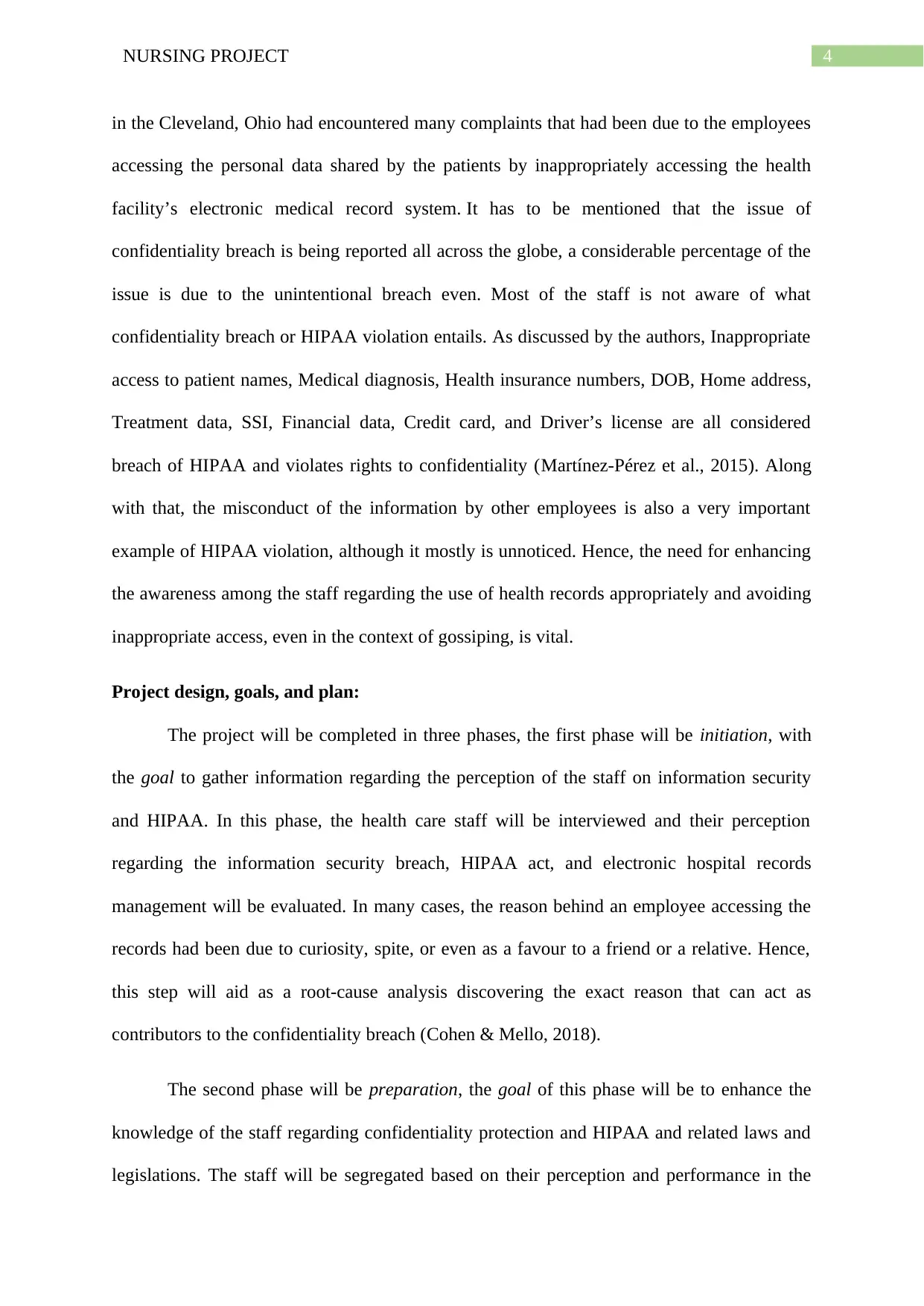
4NURSING PROJECT
in the Cleveland, Ohio had encountered many complaints that had been due to the employees
accessing the personal data shared by the patients by inappropriately accessing the health
facility’s electronic medical record system. It has to be mentioned that the issue of
confidentiality breach is being reported all across the globe, a considerable percentage of the
issue is due to the unintentional breach even. Most of the staff is not aware of what
confidentiality breach or HIPAA violation entails. As discussed by the authors, Inappropriate
access to patient names, Medical diagnosis, Health insurance numbers, DOB, Home address,
Treatment data, SSI, Financial data, Credit card, and Driver’s license are all considered
breach of HIPAA and violates rights to confidentiality (Martínez-Pérez et al., 2015). Along
with that, the misconduct of the information by other employees is also a very important
example of HIPAA violation, although it mostly is unnoticed. Hence, the need for enhancing
the awareness among the staff regarding the use of health records appropriately and avoiding
inappropriate access, even in the context of gossiping, is vital.
Project design, goals, and plan:
The project will be completed in three phases, the first phase will be initiation, with
the goal to gather information regarding the perception of the staff on information security
and HIPAA. In this phase, the health care staff will be interviewed and their perception
regarding the information security breach, HIPAA act, and electronic hospital records
management will be evaluated. In many cases, the reason behind an employee accessing the
records had been due to curiosity, spite, or even as a favour to a friend or a relative. Hence,
this step will aid as a root-cause analysis discovering the exact reason that can act as
contributors to the confidentiality breach (Cohen & Mello, 2018).
The second phase will be preparation, the goal of this phase will be to enhance the
knowledge of the staff regarding confidentiality protection and HIPAA and related laws and
legislations. The staff will be segregated based on their perception and performance in the
in the Cleveland, Ohio had encountered many complaints that had been due to the employees
accessing the personal data shared by the patients by inappropriately accessing the health
facility’s electronic medical record system. It has to be mentioned that the issue of
confidentiality breach is being reported all across the globe, a considerable percentage of the
issue is due to the unintentional breach even. Most of the staff is not aware of what
confidentiality breach or HIPAA violation entails. As discussed by the authors, Inappropriate
access to patient names, Medical diagnosis, Health insurance numbers, DOB, Home address,
Treatment data, SSI, Financial data, Credit card, and Driver’s license are all considered
breach of HIPAA and violates rights to confidentiality (Martínez-Pérez et al., 2015). Along
with that, the misconduct of the information by other employees is also a very important
example of HIPAA violation, although it mostly is unnoticed. Hence, the need for enhancing
the awareness among the staff regarding the use of health records appropriately and avoiding
inappropriate access, even in the context of gossiping, is vital.
Project design, goals, and plan:
The project will be completed in three phases, the first phase will be initiation, with
the goal to gather information regarding the perception of the staff on information security
and HIPAA. In this phase, the health care staff will be interviewed and their perception
regarding the information security breach, HIPAA act, and electronic hospital records
management will be evaluated. In many cases, the reason behind an employee accessing the
records had been due to curiosity, spite, or even as a favour to a friend or a relative. Hence,
this step will aid as a root-cause analysis discovering the exact reason that can act as
contributors to the confidentiality breach (Cohen & Mello, 2018).
The second phase will be preparation, the goal of this phase will be to enhance the
knowledge of the staff regarding confidentiality protection and HIPAA and related laws and
legislations. The staff will be segregated based on their perception and performance in the
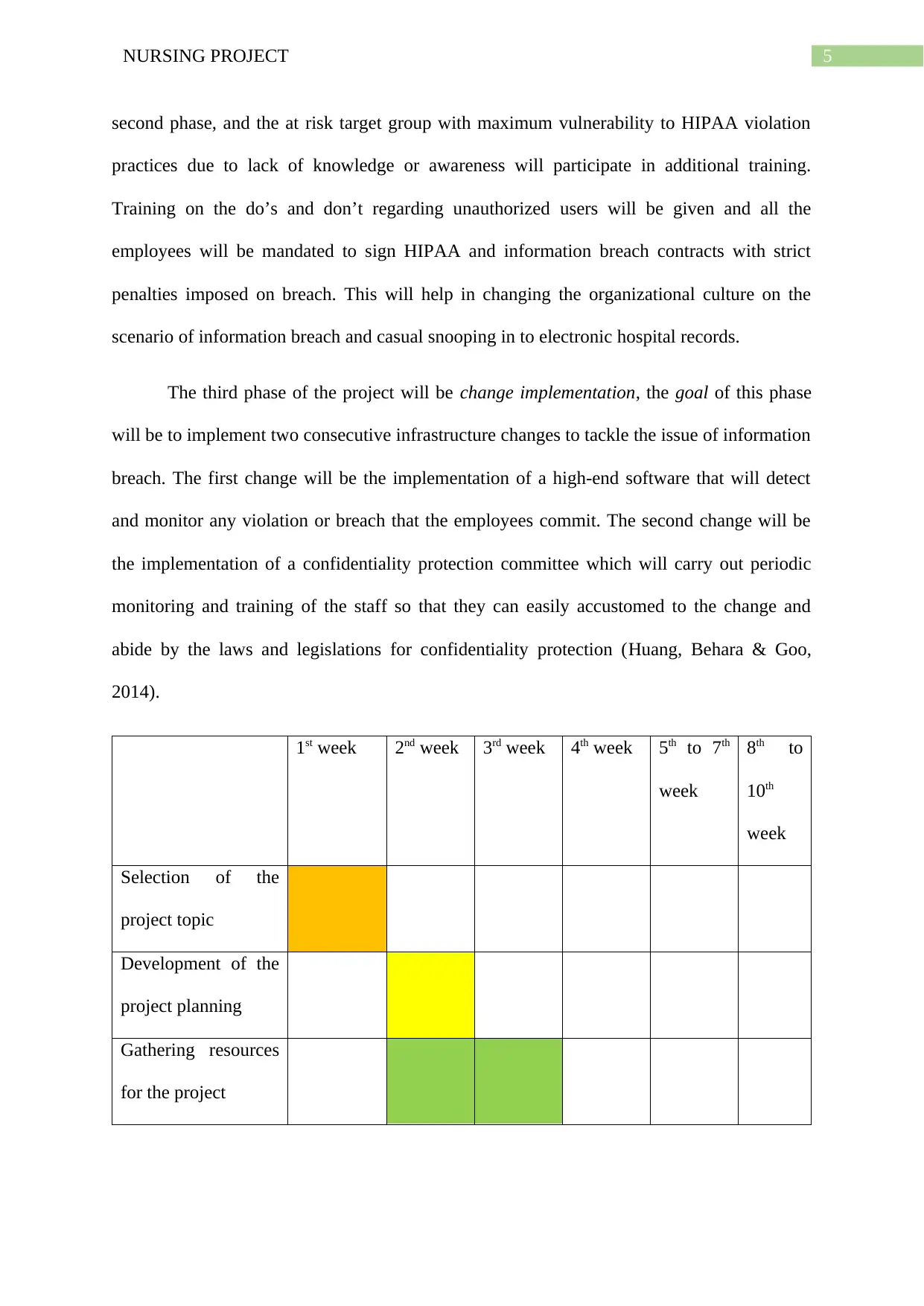
5NURSING PROJECT
second phase, and the at risk target group with maximum vulnerability to HIPAA violation
practices due to lack of knowledge or awareness will participate in additional training.
Training on the do’s and don’t regarding unauthorized users will be given and all the
employees will be mandated to sign HIPAA and information breach contracts with strict
penalties imposed on breach. This will help in changing the organizational culture on the
scenario of information breach and casual snooping in to electronic hospital records.
The third phase of the project will be change implementation, the goal of this phase
will be to implement two consecutive infrastructure changes to tackle the issue of information
breach. The first change will be the implementation of a high-end software that will detect
and monitor any violation or breach that the employees commit. The second change will be
the implementation of a confidentiality protection committee which will carry out periodic
monitoring and training of the staff so that they can easily accustomed to the change and
abide by the laws and legislations for confidentiality protection (Huang, Behara & Goo,
2014).
1st week 2nd week 3rd week 4th week 5th to 7th
week
8th to
10th
week
Selection of the
project topic
Development of the
project planning
Gathering resources
for the project
second phase, and the at risk target group with maximum vulnerability to HIPAA violation
practices due to lack of knowledge or awareness will participate in additional training.
Training on the do’s and don’t regarding unauthorized users will be given and all the
employees will be mandated to sign HIPAA and information breach contracts with strict
penalties imposed on breach. This will help in changing the organizational culture on the
scenario of information breach and casual snooping in to electronic hospital records.
The third phase of the project will be change implementation, the goal of this phase
will be to implement two consecutive infrastructure changes to tackle the issue of information
breach. The first change will be the implementation of a high-end software that will detect
and monitor any violation or breach that the employees commit. The second change will be
the implementation of a confidentiality protection committee which will carry out periodic
monitoring and training of the staff so that they can easily accustomed to the change and
abide by the laws and legislations for confidentiality protection (Huang, Behara & Goo,
2014).
1st week 2nd week 3rd week 4th week 5th to 7th
week
8th to
10th
week
Selection of the
project topic
Development of the
project planning
Gathering resources
for the project
⊘ This is a preview!⊘
Do you want full access?
Subscribe today to unlock all pages.

Trusted by 1+ million students worldwide
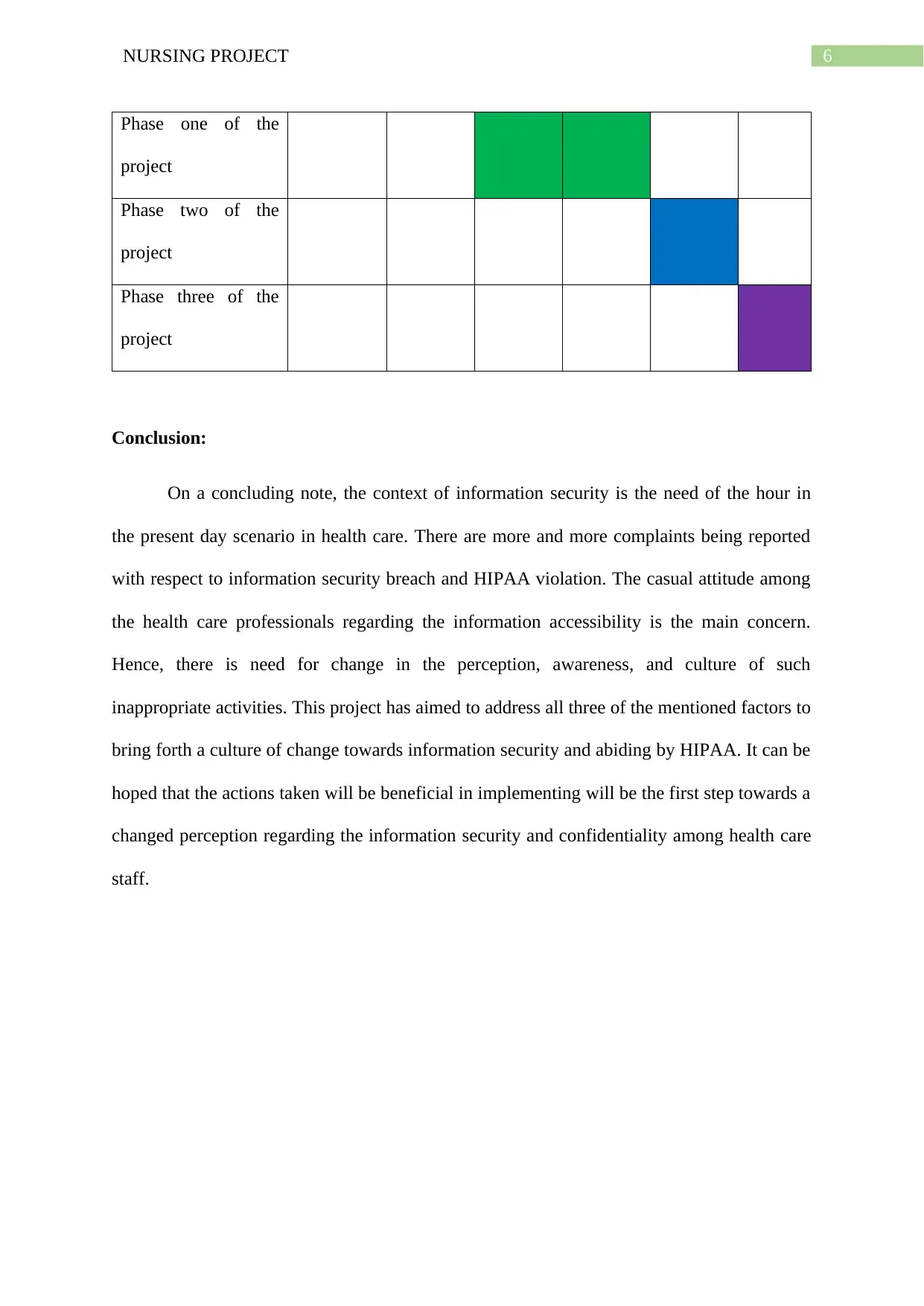
6NURSING PROJECT
Phase one of the
project
Phase two of the
project
Phase three of the
project
Conclusion:
On a concluding note, the context of information security is the need of the hour in
the present day scenario in health care. There are more and more complaints being reported
with respect to information security breach and HIPAA violation. The casual attitude among
the health care professionals regarding the information accessibility is the main concern.
Hence, there is need for change in the perception, awareness, and culture of such
inappropriate activities. This project has aimed to address all three of the mentioned factors to
bring forth a culture of change towards information security and abiding by HIPAA. It can be
hoped that the actions taken will be beneficial in implementing will be the first step towards a
changed perception regarding the information security and confidentiality among health care
staff.
Phase one of the
project
Phase two of the
project
Phase three of the
project
Conclusion:
On a concluding note, the context of information security is the need of the hour in
the present day scenario in health care. There are more and more complaints being reported
with respect to information security breach and HIPAA violation. The casual attitude among
the health care professionals regarding the information accessibility is the main concern.
Hence, there is need for change in the perception, awareness, and culture of such
inappropriate activities. This project has aimed to address all three of the mentioned factors to
bring forth a culture of change towards information security and abiding by HIPAA. It can be
hoped that the actions taken will be beneficial in implementing will be the first step towards a
changed perception regarding the information security and confidentiality among health care
staff.
Paraphrase This Document
Need a fresh take? Get an instant paraphrase of this document with our AI Paraphraser
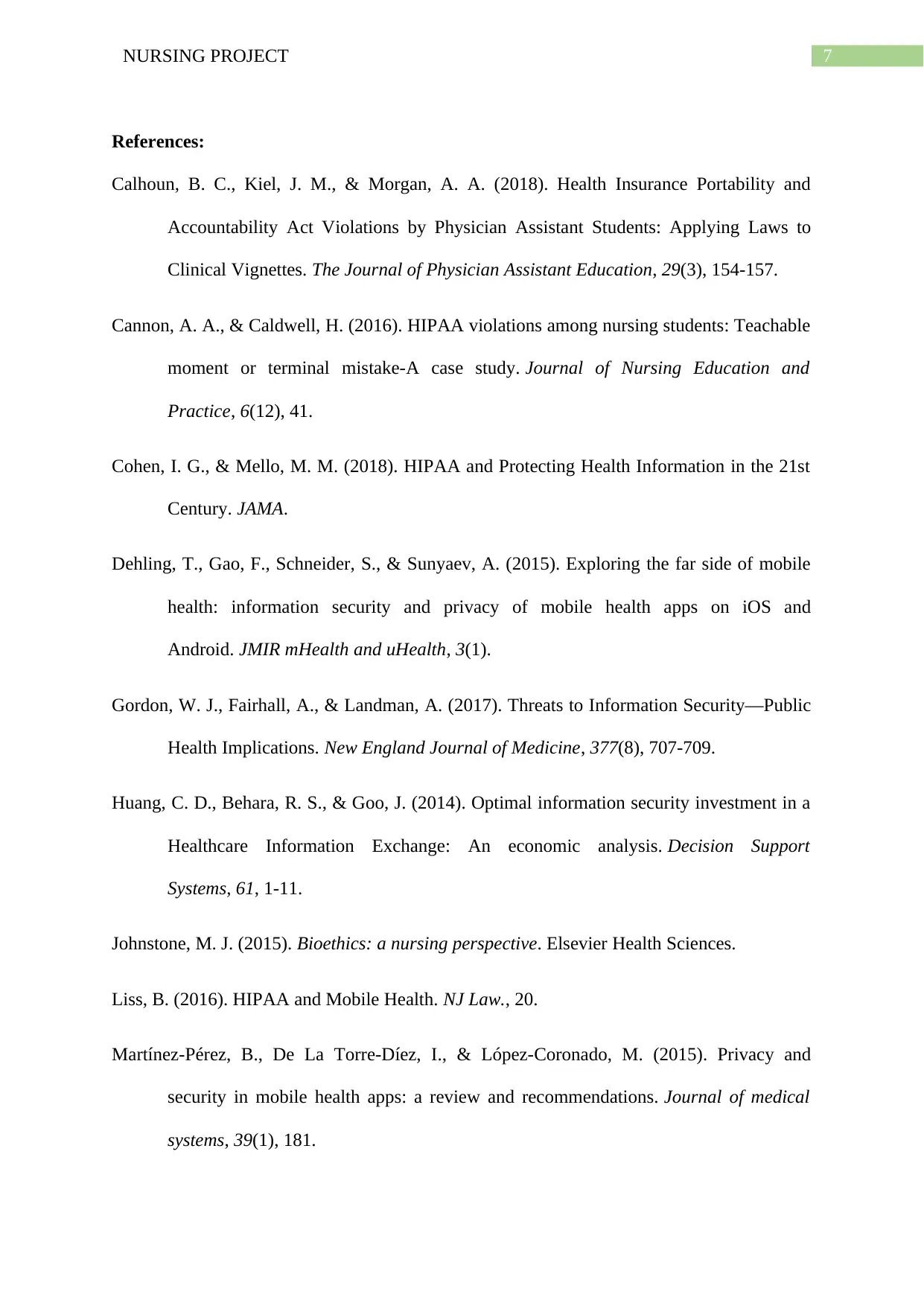
7NURSING PROJECT
References:
Calhoun, B. C., Kiel, J. M., & Morgan, A. A. (2018). Health Insurance Portability and
Accountability Act Violations by Physician Assistant Students: Applying Laws to
Clinical Vignettes. The Journal of Physician Assistant Education, 29(3), 154-157.
Cannon, A. A., & Caldwell, H. (2016). HIPAA violations among nursing students: Teachable
moment or terminal mistake-A case study. Journal of Nursing Education and
Practice, 6(12), 41.
Cohen, I. G., & Mello, M. M. (2018). HIPAA and Protecting Health Information in the 21st
Century. JAMA.
Dehling, T., Gao, F., Schneider, S., & Sunyaev, A. (2015). Exploring the far side of mobile
health: information security and privacy of mobile health apps on iOS and
Android. JMIR mHealth and uHealth, 3(1).
Gordon, W. J., Fairhall, A., & Landman, A. (2017). Threats to Information Security—Public
Health Implications. New England Journal of Medicine, 377(8), 707-709.
Huang, C. D., Behara, R. S., & Goo, J. (2014). Optimal information security investment in a
Healthcare Information Exchange: An economic analysis. Decision Support
Systems, 61, 1-11.
Johnstone, M. J. (2015). Bioethics: a nursing perspective. Elsevier Health Sciences.
Liss, B. (2016). HIPAA and Mobile Health. NJ Law., 20.
Martínez-Pérez, B., De La Torre-Díez, I., & López-Coronado, M. (2015). Privacy and
security in mobile health apps: a review and recommendations. Journal of medical
systems, 39(1), 181.
References:
Calhoun, B. C., Kiel, J. M., & Morgan, A. A. (2018). Health Insurance Portability and
Accountability Act Violations by Physician Assistant Students: Applying Laws to
Clinical Vignettes. The Journal of Physician Assistant Education, 29(3), 154-157.
Cannon, A. A., & Caldwell, H. (2016). HIPAA violations among nursing students: Teachable
moment or terminal mistake-A case study. Journal of Nursing Education and
Practice, 6(12), 41.
Cohen, I. G., & Mello, M. M. (2018). HIPAA and Protecting Health Information in the 21st
Century. JAMA.
Dehling, T., Gao, F., Schneider, S., & Sunyaev, A. (2015). Exploring the far side of mobile
health: information security and privacy of mobile health apps on iOS and
Android. JMIR mHealth and uHealth, 3(1).
Gordon, W. J., Fairhall, A., & Landman, A. (2017). Threats to Information Security—Public
Health Implications. New England Journal of Medicine, 377(8), 707-709.
Huang, C. D., Behara, R. S., & Goo, J. (2014). Optimal information security investment in a
Healthcare Information Exchange: An economic analysis. Decision Support
Systems, 61, 1-11.
Johnstone, M. J. (2015). Bioethics: a nursing perspective. Elsevier Health Sciences.
Liss, B. (2016). HIPAA and Mobile Health. NJ Law., 20.
Martínez-Pérez, B., De La Torre-Díez, I., & López-Coronado, M. (2015). Privacy and
security in mobile health apps: a review and recommendations. Journal of medical
systems, 39(1), 181.
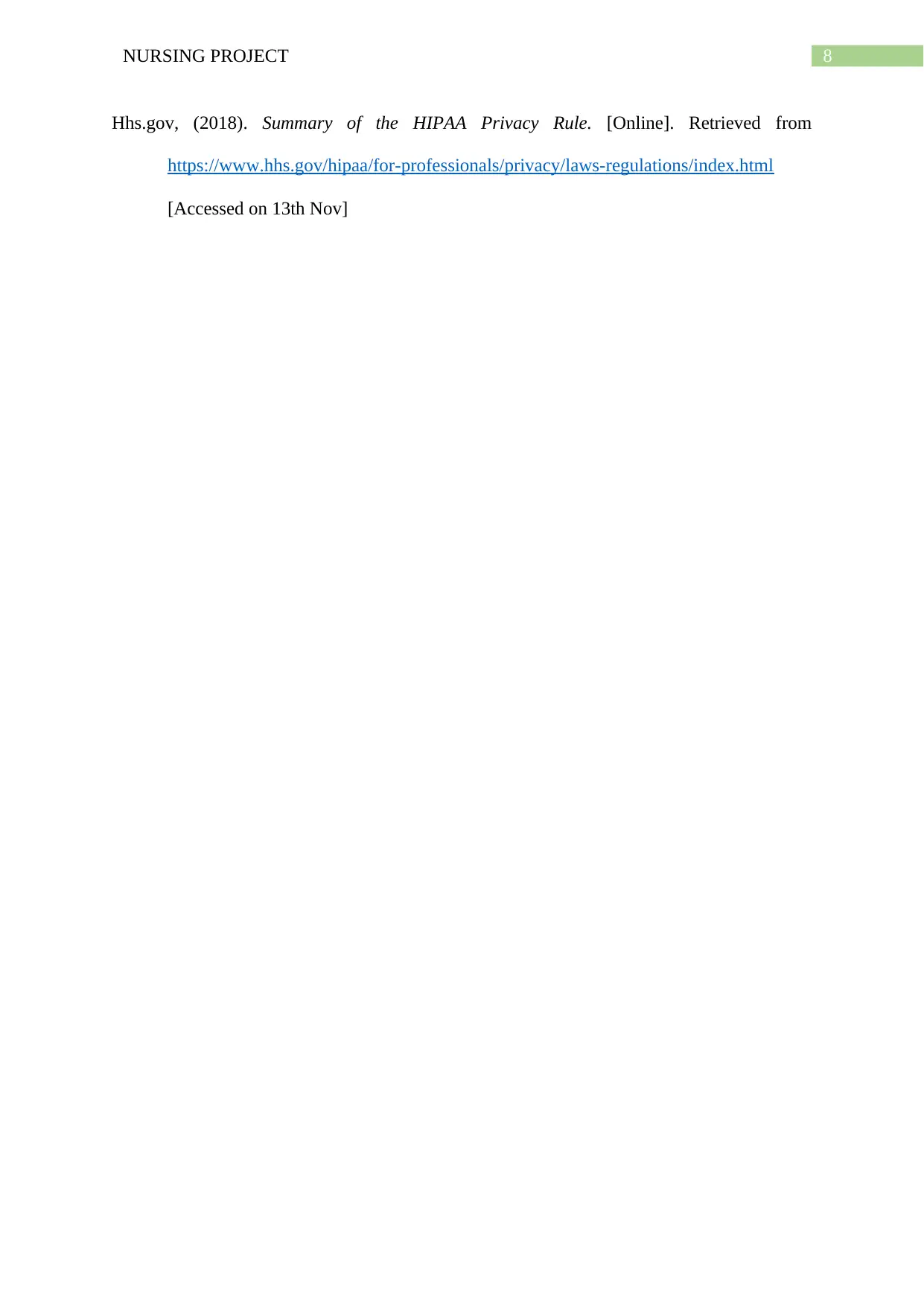
8NURSING PROJECT
Hhs.gov, (2018). Summary of the HIPAA Privacy Rule. [Online]. Retrieved from
https://www.hhs.gov/hipaa/for-professionals/privacy/laws-regulations/index.html
[Accessed on 13th Nov]
Hhs.gov, (2018). Summary of the HIPAA Privacy Rule. [Online]. Retrieved from
https://www.hhs.gov/hipaa/for-professionals/privacy/laws-regulations/index.html
[Accessed on 13th Nov]
⊘ This is a preview!⊘
Do you want full access?
Subscribe today to unlock all pages.

Trusted by 1+ million students worldwide
1 out of 9
Related Documents
Your All-in-One AI-Powered Toolkit for Academic Success.
+13062052269
info@desklib.com
Available 24*7 on WhatsApp / Email
![[object Object]](/_next/static/media/star-bottom.7253800d.svg)
Unlock your academic potential
Copyright © 2020–2025 A2Z Services. All Rights Reserved. Developed and managed by ZUCOL.




